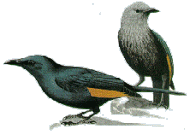
Dr Sally Hofmeyr
BSc(Agric) (University of Natal), MSc (University of Pretoria), PhD (UCT)
Sally decided to study wildlife science after going on a wilderness trail in the Umfolozi Game Reserve as a teenager. During her undergraduate studies, she discovered the wonder of bird ringing and birding. She completed her MSc in African Mammals at Pretoria, which included a research project on giraffes in the Kruger National Park. She took a few years out of university, doing (among other things) outdoor education for British school children, aerial photography in South Africa and Mozambique, and an internship with the IUCN.
Eventually she returned to academia and did a PhD and a postdoc in ornithology at the Animal Demography Unit, UCT. For these projects she used citizen science data to look at how large terrestrial birds (cranes, bustards, korhaans, secretarybirds) were responding to environmental change. During that time she qualified for her bird ringing licence and established a constant-effort bird ringing site in Cape Town. She also became involved in penguin monitoring work on Robben Island and post-fire bird monitoring on the Cape Peninsula. She did a second postdoc, also with the ADU, on science communication.
Sally worked mainly as a freelance academic editor from 2016 to 2023, but in 2018 she joined the FitzPatrick Institute on an ad hoc basis as a field technician on the Red-winged Starling Project on campus, catching and colour-ringing the birds as part of a long-term monitoring project. In 2023 she joined the Fitz formally as interim course convenor for the Conservation Biology MSc programme until December 2024.
In 2025 she took over from Hilary Buchanan as research and postgraduate administrator for the Fitz and also took on a part-time role as Senior Scientific Officer for SAFRING, the national and regional bird ringing authority, which is hosted at the Fitz. She continues her work on the Red-winged Starling Project and, during breeding season, can often be seen up a ladder anywhere on Upper Campus, accessing starling nests to continue the project's chick ringing and monitoring work. Her constant-effort ringing site is ongoing, and the monthly ringing sessions there are attended by many trainee bird ringers from the university and the greater Cape Town area.
Peer-reviewed publications:
Bates A.E., Primack R.B., Biggar B.S., et al. 2021. Global COVID-19 lockdown highlights humans as both threats and custodians of the environment. Biological Conservation. doi: 10.1016/j.biocon.2021.109175
Mills, A.J., Spear, D., Ndhlovu, T., Knight, M.H., Peinke, D.M., Hofmeyr, S.D. and Cowling, R.M. 2014. Biomass of large herbivores in South African subtropical thicket. African Journal of Ecology. doi: 10.1111/aje.12162.
Hofmeyr, S.D., Symes, C.T. and Underhill, L.G. 2014. Secretarybird Sagittarius serpentarius population trends and ecology: insights from South African citizen science data. PLoS ONE 9(5): e96772. doi:10.1371/journal.pone.0096772.
Fleming, P.A., Hofmeyr, S.D., Nicolson, S.W. and du Toit, J.T. 2006. Are giraffes pollinators or flower predators of Acacia nigrescens in Kruger National Park, South Africa? Journal of Tropical Ecology 22:247-253.
Fleming, P.A., Hofmeyr, S.D. and Nicolson, S.W. 2007. Role of insects in the pollination of Acacia nigrescens (Fabaceae). South African Journal of Botany 73:49-55.
Contributor to:
De Villiers, M.S. (ed.). 2009. Birds and Environmental Change: building an early warning system in South Africa. SANBI, Pretoria
